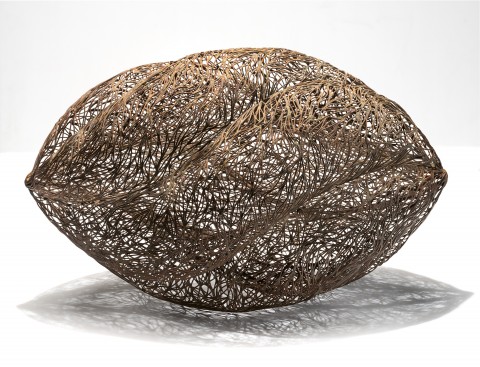BUD, 2003
BRONWYN OLIVER
copper
36.0 x 57.0 x 36.0 cm
Roslyn Oxley9 Gallery, Sydney, commissioned by Gary Sands, Queensland
Christie’s, Sydney, 24 May 2005, lot 45 (as 'Pod')
Private collection, Sydney
Fink, H., Bronwyn Oliver: Strange Things, Piper Press, Sydney, 2017, p. 220
Bud II, 2004, 115.0 x 95.0 x 95.0 cm, MONA Collection, Tasmania, illus. ibid., pp. 172-173
Today recognised as one of Australia's foremost contemporary artists, the late sculptor Bronwyn Oliver produced an extraordinary body of copper works of poised elegance, evoking the timeless organic forms of the natural world and animated with repeating geometric patterns and taut physical tension. In 1999, Oliver had received her first major sculptural commission from the City of Sydney, for which she created a pair of oversized seed forms made of welded copper, Palm and Magnolia (Royal Botanic Gardens, Sydney). Following the public success of these sculptures, in the early 2000s she experienced a flurry of private commissions for similar works in closed spherical and ovoidal volumes, realised in monumental dimensions to be installed in gardens while others remained in an intimate and domestic scale.1 Bud, 2003, is one such work, a delicately tapered ovoid vessel, its latticed filigree copper surface is fluted with symmetrical spiral ribbing - these pronounced ridges animating the static sculpture with an implied rotational potential. This effect characterised many of Oliver’s most successful closed-form works of the period, including Magnolia (1999), Twill, (2001), Entwine (2001) and Tracery (2003), most following a vertical droplet shape. The perforated transparency of Oliver’s fretwork provides a contrasting tension between the appearance of rigid carapace and the void enclosed within, through which the sculpture breathes. For the artist, the seed form was employed as a sign of new beginnings, conveying the possibility of metamorphosis, the potential of an unseen life force to break free from its cocoon.
Oliver’s sculptures, although often bearing mimetic titles such as bud, pod, chrysalis and shell, are not about nature, instead their appearances are shaped by the conceptual power of natural forms and the effects of their shape and volume in physical space that surrounds them - breathing and moving in three dimensions. In describing her most successful works, Bronwyn Oliver remarked that with a perfect combination of concept, medium and execution, the sculpture would ‘sing’, and using a ‘poetry of association’, would transcend conventional markers of time and space.2 The instinct to grapple with poetic associations is human, and a carefully laid trap that Bronwyn Oliver, as Arachne, has woven for her audience. Self-contained, Bud twists and concertinas, its shining woven copper threads and tendrils glowing with internal and reflected warmth and inviting tactility. Presenting a sense of wholeness, its enigmatic existence remains unquestioned and immutable, as though Bud had appeared in this world fully formed. This elegance and masterful resolution, however, belies the punishing, labour-intensive process to which Oliver was so rapturously committed - the painstakingly manipulated twisting and welds of pliant copper wire here creating an intricate ‘weave': the microstructure of her organic sculptural form, open and geometric, allowing light to permeate and magnify its decorative surface patterns.
Created in 2003, Bud is an immaculate artefact from the abundantly productive apogee of Oliver’s career. Having relinquished her teaching job the year before, the artist threw herself into producing work for private commissions, including the monumental Tracery, 2003 and commencing her most ambitious sculpture, the 16.5m suspended Vine in the atrium of the Sydney Hilton Hotel.
1. Fink, H., Bronwyn Oliver – Strange Things, Paper Press, Sydney, 2017, p. 136
2. Sturgeon, G., Contemporary Australian Sculpture, Craftsman House, Sydney, 1991, pp. 73 – 74
LUCIE REEVES-SMITH
